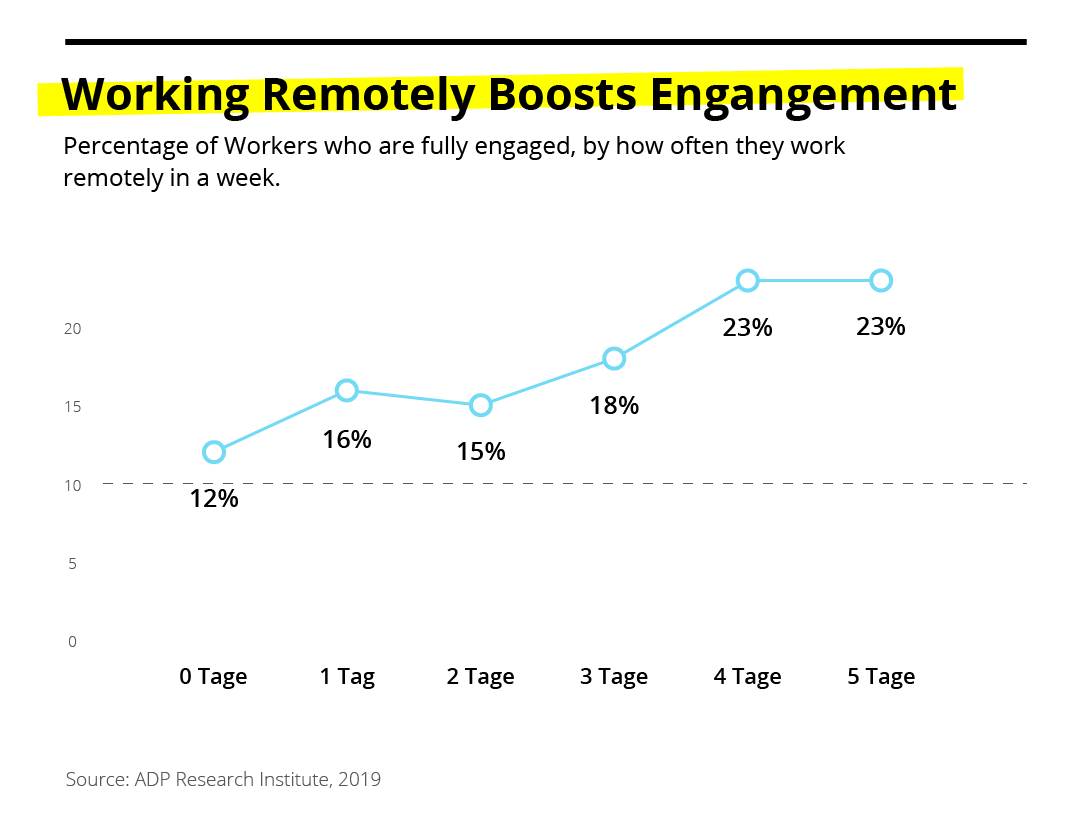Is Your Company Ready for Remote Work?

By offering home and remote working, companies can accommodate their employees’ desire for flexibility. However, these working models pose special challenges.
What can HR do to successfully introduce and manage remote work in the company – even in times of crisis? Find out more in this article.
This checklist can help you successfully put remote work into practice.Generation Y – that is, 20- to 35-year-olds – who are in great demand on the labor market want a well-adjusted work-life balance and the necessary space for their own individual development. Employers need to meet these expectations and enable their employees to work flexibly in terms of time and location. Remote work, that is, being able to work at home, in a café, on the beach or anywhere else in the world, is one of the essential components of this new world of work.
Young Talent Demands Remote Work
Remote work isn’t just "nice to have." In a representative Bitkom survey, over a third of all employees questioned said that they would be happy to leave their current position in exchange for more flexibility and the chance to work remotely. So, whether you offer your employees flexible working models can be decisive for whether you can attract and retain talent.
Over one third of employees say they would leave their current employer for more flexibility and the chance to work from home.
Is remote work already established at your company? At the very latest, the first time one of your employees asks their team leader about the possibility of regularly working from home is when you, as an HR manager, should be dealing with this topic.
Impress Young Talent With Your Corporate Culture

Expert insights, step-by-step instructions and numerous practical examples: In this guide, you will learn how to set specific goals, embed clear values and purposefully control and measure your corporate culture.
Download Our Guide NowWhat Are the Benefits of Remote Work?
Is remote work just a concession to employees, or does this kind of working model offer real benefits for companies? According to reliable studies, there are real advantages.
There is a real need for remote work among the young digital generation, and it will prove to be a powerful argument in your favor during the recruitment process. An international study carried out by Buffer and AngelList revealed that 98% of respondents (would) like to work remotely. They gave reasons such as increased flexibility, no commuting and more family time.
In the IT and technology sector, the only available specialists are often a long ways away, maybe even in another country. Offering the option of working at home is often the only way to attract such skilled workers.
You will need less space in your company building and will save on occupancy costs. (However, this should be a nice side benefit rather than your driving motivation.)
Employees who (occasionally) work from home or elsewhere are happier, more productive and take less time off sick.

What Are the Challenges of Remote Work?
Of course, location-independent working does not guarantee happiness for your company and your employees. It brings with it a number of challenges that you will need to take seriously and deal with:
The lack of personal contact can cause the cohesion, collaboration and communication within your company to suffer.
A real or perceived division may occur between the “office workers” and the “home workers.” In a corporate culture that was previously based very much on employees being present and supervised, the introduction of remote work can be unsettling.
Working from outside the company premises entails some legal risks.
How to Introduce Remote Working
How can you successfully deal with the challenges involved and, above all, take full advantage of the opportunities and benefits offered by flexible workplace models?
Checklist: How to Establish Remote Work

Remote work will accompany HR departments in the long term. This checklist gives you tips on what to consider when establishing remote work.
Download the checklist hereDefine Who Is Entitled to Work at Home or Remotely
Together with your specialist departments, determine which areas of responsibility, teams or positions are suitable for remote work. Decide on clear, understandable rules. If everyone knows who is entitled to work remotely, as well as when and why, envy and rivalry between employees can be avoided.
Basically, areas in which work results can be measured qualitatively (e.g. project goals) or quantitatively (e.g. accepted calls in a call centre) and where the work is digitalized to a high degree are suitable. Do not be too narrow-minded. With the right basic parameters, almost any “desk job” can be done remotely.
Set Out the Basic Parameters
Extend your employees’ internal guidelines and work contracts as required. Questions regarding workplace equipment, meeting the costs of office supplies, electricity and insurance will need to be answered. Software solutions make it easy for employees to request absences from the office, while also keeping supervisors and colleagues informed (via the automatic calendar entry). This makes the process transparent and involves all employees.
In addition, it is important to make rules about working hours and breaks during remote work and to determine how often or at what times employees must be present on-site. Rules like these provide security for everyone involved because they understand what is expected of them. Investigate whether employee goals and performance reviews will need to be adapted to the new situation. A standardized orientation plan (onboarding) for new hires is a must for companies that offer location-independent working.
However, give your departments enough leeway to respond to individual requirements. Rigid, uniform remote work rules for both call center employees and software developers, for example, are certainly not recommended.
Make Sure Offices and Home Offices Are Adequately Equipped
Ergonomic office furniture is a legal requirement. The technology and software provided are a major factor in determining whether remote work is enjoyable and runs smoothly. It is only with the right software tools for communication (e.g. video conferencing and online messaging) and collaboration (e.g. project management solutions and knowledge databases) that you can reap the productivity benefits of remote work.
Changes may also be necessary in your company building. After all, on the one hand, your employees will need space when they are on-site. On the other, you don’t want your offices to be empty for half the week. An “open space” office environment is a modern and workable option. Here, the employees who come in can choose where they want to sit, form teams and easily get chatting.
Train Your Managers
Leading a team is never easy. If the team is spread out over different locations and only meets up every now and then, it is a special challenge. Remote work places high demands on a manager’s communication, moderation and motivation skills. Be sure to train your managers for this special task. Support them when there are team conflicts.
Help them to work with their subordinates to formulate appropriate employee goals. Employees who work remotely are often at a disadvantage when it comes to promotions. Their successes are simply less visible. A standardized performance review system will help managers to recognize and promote talent.
Promote Personal Contact Between Teams
Video conferencing and online messaging are great, but they can never replace personal contact. The rarer it is for colleagues to be working together in the same office, the more important face-to-face meetings are. Organise regular team-building activities for your specialist departments.
The Greatest Challenges for Employees
According to an international study carried out by Buffer and AngelList, communication, collaboration and loneliness are the three biggest problems with remote work. So, it’s all the more important for HR and companies to work on (digital) initiatives to enable trouble-free collaboration.
The required frequency and effort involved depend on how many employees work remotely, and how often. It could range from a weekly status meeting followed by a company breakfast on Monday mornings to an annual company event where colleagues are flown in from different continents. And one not altogether unimportant detail that you should not forget: The budgets for pizza, beer, a DJ and hotel accommodations should be planned in advance!
Hire Employees You Trust
This may be the last point on our list, but it is perhaps the most important. Your employees will have to deal with the challenges of remote work – a high level of personal responsibility, a certain amount of social isolation and a high degree of digitalization. You, on the other hand, must be able to trust your employees to do their best without being constantly under the boss’s watchful eye. A lack of trust in their employees’ motivation levels is one of the main arguments that companies use against remote work.
However, if you do not fully trust an employee, whether they are sitting in your office or not, it does beg the question: Why did you hire them in the first place? Contrary to employers’ misgivings, the average productivity of employees who work at home increases, as studies have shown. During the selection process, make sure that candidates have the necessary character and skills to work independently, regardless of location.
Most people will already know whether they are someone who works well at home or whether they would rather go into the office and see their colleagues every day. After one trial with 250 employees, half of the test subjects decided after a few months of working at home that they would rather go back to the office. The direct question in the interview “Would you like to work remotely, and why (not)?” is a simple and effective way to find out whether a candidate is suitable for remote work or not.
Make Remote Work Successful
Flexible working models like remote work are by no means a sure-fire success and can very well go wrong. From time to time, there are reports that corporations such as IBM or Yahoo are bringing thousands of remote workers back into their offices, (ostensibly) on the grounds of productivity. On the other hand, there are success stories like that of the US software company Buffer, where over 75 employees from all time zones around the world work completely remotely and generate annual sales of 14 million US dollars (as of May 2017).
The accounts given by Buffer employees are a source of inspiration for any company that is considering introducing location-independent working. So, it all depends how you go about things. Develop an individual concept that suits your company. Try out remote work in one or more trial teams, evaluate the results and optimize them. Then you can roll out the concept across your entire company. Do not forego the advantage that flexible, remote working models will give you when it comes to finding and retaining new talent. Remember that 35% of all employees would be willing to change employers for these benefits. Wouldn’t it be nice if they came to you rather than one of your competitors?
Manage Remote Work the Easy Way

The number of people who regularly work from home has been increasing for years. The desire for standardized rules for home officing is growing. In response, we recommend that you adapt your HR processes through digitalization. Personio is here to support you in this process.
Learn more hereDisclaimer
We would like to inform you that the contents of our website (including any legal contributions) are for non-binding informational purposes only and does not in any way constitute legal advice. The content of this information cannot and is not intended to replace individual and binding legal advice from e.g. a lawyer that addresses your specific situation. In this respect, all information provided is without guarantee of correctness, completeness and up-to-dateness.
